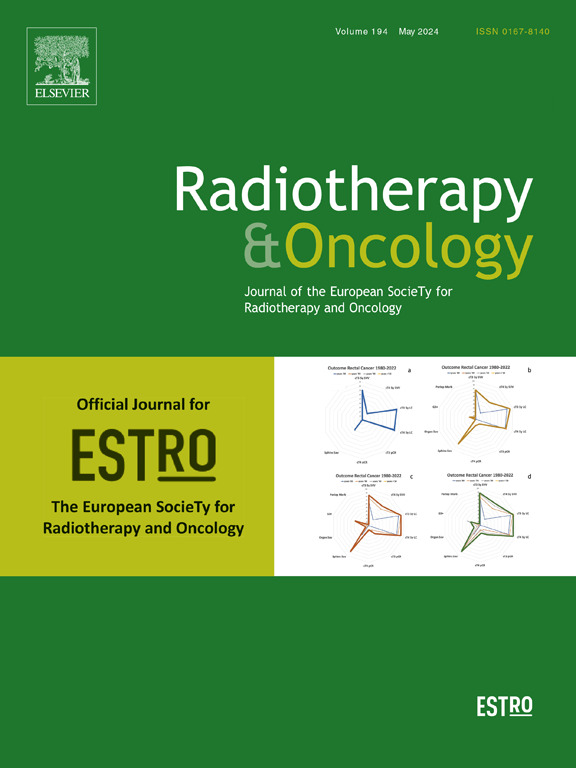乳腺癌放疗计划 CT 自动分割:最新进展综述。
IF 4.9
1区 医学
Q1 ONCOLOGY
引用次数: 0
摘要
在乳腺癌(BC)治疗中,术后放疗(RT)已被证明能有效降低疾病复发率和死亡率。计划工作流程中的一个关键步骤是准确划分临床靶体积(CTV)和危险器官(OAR)。本文献综述评估了深度学习(DL)和基于图集的自动轮廓绘制技术在用于 RT 的 BC 计划 CT 图像的 CTV 和 OAR 方面的最新进展。它考察了这两种技术在几何和剂量测定准确性、观察者间变异性和时间效率方面的表现。我们的研究结果表明,基于 DL 和基于图集的方法在 OAR 和 CTV 上的表现基本相当,而 DL 方法在一致性和准确性上略胜一筹。乳腺和大多数 OAR 的自动分割在分割质量和剂量规划方面都取得了很好的效果。然而,淋巴结水平(LNL)是自动分割的最大挑战,对剂量规划有重大影响。由于几何性能指标和剂量评估研究的缺乏,这些发现在临床实践中的应用受到了限制。此外,自动构图算法显示出不同的结构集,而训练数据集的大小、来源、患者定位和成像方案各不相同,影响了模型的灵敏度。指南的不一致和对地面实况的不同定义导致了巨大的差异,这表明需要一个可靠的共识训练数据集。最后,我们的综述强调了 U-Net 架构的受欢迎程度。总之,虽然自动轮廓绘制已被证明对许多 OAR 和乳腺-CTV 有效,但在 LNL 划分、剂量分析和建立共识方面仍需进一步改进。本文章由计算机程序翻译,如有差异,请以英文原文为准。
Automated segmentation in planning-CT for breast cancer radiotherapy: A review of recent advances
Postoperative radiotherapy (RT) has been shown to effectively reduce disease recurrence and mortality in breast cancer (BC) treatment. A critical step in the planning workflow is the accurate delineation of clinical target volumes (CTV) and organs-at-risk (OAR). This literature review evaluates recent advancements in deep-learning (DL) and atlas-based auto-contouring techniques for CTVs and OARs in BC planning-CT images for RT. It examines their performance regarding geometrical and dosimetric accuracy, inter-observer variability, and time efficiency. Our findings indicate that both DL- and atlas-based methods generally show comparable performance across OARs and CTVs, with DL methods slightly outperforming in consistency and accuracy. Auto-segmentation of breast and most OARs achieved robust results in both segmentation quality and dosimetric planning. However, lymph node levels (LNLs) presented the greatest challenge in auto-segmentation with significant impact on dosimetric planning. The translation of these findings into clinical practice is limited by the geometric performance metrics and the lack of dose evaluation studies. Additionally, auto-contouring algorithms showed diverse structure sets, while training datasets varied in size, origin, patient positioning and imaging protocols, affecting model sensitivity. Guideline inconsistencies and varying definitions of ground truth led to substantial variability, suggesting a need for a reliable consensus training dataset. Finally, our review highlights the popularity of the U-Net architecture. In conclusion, while automated contouring has proven efficient for many OARs and the breast-CTV, further improvements are necessary in LNL delineation, dosimetric analysis, and consensus building.
求助全文
通过发布文献求助,成功后即可免费获取论文全文。
去求助
来源期刊

Radiotherapy and Oncology
医学-核医学
CiteScore
10.30
自引率
10.50%
发文量
2445
审稿时长
45 days
期刊介绍:
Radiotherapy and Oncology publishes papers describing original research as well as review articles. It covers areas of interest relating to radiation oncology. This includes: clinical radiotherapy, combined modality treatment, translational studies, epidemiological outcomes, imaging, dosimetry, and radiation therapy planning, experimental work in radiobiology, chemobiology, hyperthermia and tumour biology, as well as data science in radiation oncology and physics aspects relevant to oncology.Papers on more general aspects of interest to the radiation oncologist including chemotherapy, surgery and immunology are also published.
 求助内容:
求助内容: 应助结果提醒方式:
应助结果提醒方式:


